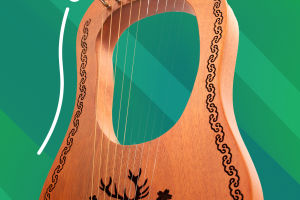The guitar is a highly popular stringed instrument that is widely used in various musical genres and playing styles.
It typically comprises a wooden body, neck, and fingerboard, and is equipped with six strings. Guitars can be played using either fingers or picks.
Now, let's delve into a detailed description of the guitar's main components and features:
1. Body: The guitar body is commonly crafted from wood, with materials like mahogany, redwood, and beech being frequently used. There is a wide range of body shapes available, but the most common ones are the Dreadnought and Classical shapes. Different body shapes can significantly influence the tonal quality of the guitar.
2. Neck: The neck connects the guitar body to the headstock and is usually made of hardwood. Metal frets are positioned along the neck to divide the scales. The neck features tuning pegs, which are used to adjust the pitch of the guitar.
3. Fingerboard: The fingerboard is situated above the neck and is typically made of hardwood such as rosewood or beech. It contains metal frets that indicate the scale and note positions. Guitarists press the strings against the fingerboard to produce different pitches.
4. Strings: A standard guitar has six strings arranged from lowest to highest pitch. The standard tuning is EADGBE, which corresponds to the notes Mi (E), La (A), Re (D), Sol (G), Si (B), and Mi (E). Strings can be made of steel or nylon, and the choice of material affects the sound and feel of the guitar.
5. Bridge: The bridge is located on the guitar body and serves to support the strings and transmit vibrations. It can be a fixed bridge or an adjustable one, depending on the type of guitar.
6. Pickups: Some guitars are equipped with electroacoustic pickups that convert the guitar's sound into an electrical signal. This signal can then be connected to an amplifier or audio device for amplification and recording.
Guitars come in various types and styles, including classical guitars, acoustic guitars, electric guitars, and bass guitars, among others. Each type of guitar possesses distinct characteristics and is suited to different musical applications.
The guitar plays a vital role in music, serving as a solo instrument, an accompaniment instrument for harmonies, or a rhythmic instrument. It is capable of a wide range of musical expressions and emotions. The guitar finds its place in numerous music genres such as pop, rock, jazz, blues, country, and more.
When learning the guitar, it's important to keep the following considerations in mind:
1. Finding the Right Guitar: Selecting a guitar that suits your body size and hand shape is crucial. For adults, starting with a classical guitar with nylon strings is generally recommended due to the reduced finger pressure.
If you're more interested in electric or steel-string guitars, you can transition to those types after acquiring basic techniques.
2. Finding Quality Learning Resources: You can opt for guitar lessons or explore online tutorials and videos as learning resources. Ensure that the chosen materials or instructors provide systematic and progressive guidance to help you develop a solid foundation of skills.
3. Mastering Proper Posture and Technique: Learning correct guitar posture and technique is vital for effective skill development and injury prevention. Familiarize yourself with appropriate sitting or standing positions, maintain a natural wrist bend, and practice correct finger placement, among other aspects.
4. Consistent Practice: Regular practice is key to improving guitar skills. Allocate sufficient and well-structured practice time. Dedicate specific practice sessions to different techniques, including chord transitions, scale exercises, and finger dexterity exercises.
5. Listening and Imitation: Actively listen to a variety of guitar music and attempt to emulate different techniques and styles. This helps develop your musicality and playing approach.
Remember that learning guitar requires patience and persistence. With dedicated practice and proper instruction, you will steadily enhance your skills and find enjoyment and fulfillment in your guitar journey. Best of luck in your guitar-learning endeavors!


